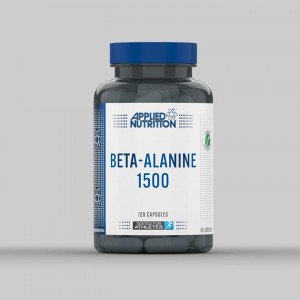Applied Nutrition Beta – Alanine 1500
Beta Alanine 1500 is a product from UK based company Applied Nutrition. This review will aim to examine the ingredients in this product to see who it might be relevant for.
Ingredients
Beta-Alanine
Beta – Alanine is a non-essential amino acid. In a wide range of studies beta – alanine has been shown to have benefits to high intensity exercise (1). The reason behind this is that it has been found to increase muscle carnosine concentrations (2). Carnosine is key to the intracellular PH buffering of skeletal muscle (3). With an increase in clearance of H+ ions, it leads to high intensity exercise lasting for longer.
Bulking Agents (Di-Calcium Phosphate, Microcrystalline Cellulose)
Calcium phosphate is formed from calcium and phosphorus properties. It can help to aid the growth and maintenance of bones (4). Other important benefits of calcium include helping blood clotting (5), heart contractions (6), lungs (7) and muscles to function properly (8), this is due to calcium binding with phosphate to create calcium phosphate (9).
Microcrystalline cellulose is water-soluble and derived from cellulose. Carboxymethyl cellulose is used as a viscosity modifier or thickener, and to stabilize emulsions in various supplements and other products. It is known for its excellent water retaining capacity.
HPMC (Vegetarian Capsule Shell).
HPMC stands for hydroxypropyl methylcellulose or hypromellose for short. It is a capsule to encases’ supplements. It is clear and tasteless; comes in vegetarian and vegan forms and provides no nutritional benefit.
Summary
This product contains ingredients that can help with High intensity interval training (HIIT). This product should be consumed twice a day with 2 capsules. This product has no banned substances when referring to the WADA prohibited list when observing the label / ingredients posted on the website.
*NOTE – This product has not been tested in a laboratory and may contain other substances that may not appear on the label
References
1 – Baguet, A., Koppo, K., Pottier, A., & Derave, W. (2010). β-Alanine supplementation reduces acidosis but not oxygen uptake response during high-intensity cycling exercise. European journal of applied physiology, 108(3), 495-503.
2 – Sale, C., Saunders, B., & Harris, R. C. (2010). Effect of beta-alanine supplementation on muscle carnosine concentrations and exercise performance. Amino acids, 39(2), 321-333.
3 – Parkhouse, W. S., McKenzie, D. C., Hochachka, P. W., & Ovalle, W. K. (1985). Buffering capacity of deproteinized human vastus lateralis muscle. J Appl Physiol, 58(1), 14-7.
4 – Harada, S. I., & Rodan, G. A. (2003). Control of osteoblast function and regulation of bone mass. Nature, 423(6937), 349-355.
5 – Bogdanova, A., Makhro, A., Wang, J., Lipp, P., & Kaestner, L. (2013). Calcium in Red Blood Cells—A Perilous Balance. International journal of molecular sciences, 14(5), 9848-9872.
6 – Dhalla, N. S., Pierce, G. N., Panagia, V., Singal, P. K., & Beamish, R. E. (1982). Calcium movements in relation to heart function. Basic research in cardiology, 77(2), 117-139.
7 – Hawgood, S., Benson, B. J., & Hamilton Jr, R. L. (1985). Effects of a surfactant-associated protein and calcium ions on the structure and surface activity of lung surfactant lipids. Biochemistry, 24(1), 184-190.
8 – Berchtold, M. W., Brinkmeier, H., & Müntener, M. (2000). Calcium ion in skeletal muscle: its crucial role for muscle function, plasticity, and disease.Physiological reviews, 80(3), 1215-1265.
9 – Shanahan, C. M., Crouthamel, M. H., Kapustin, A., & Giachelli, C. M. (2011). Arterial calcification in chronic kidney disease: key roles for calcium and phosphate. Circulation research, 109(6), 697-711.

| Use for | Endurance |
| Website | Appliednutrition.uk |
| Price | £24.95 |




